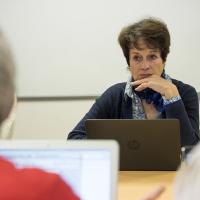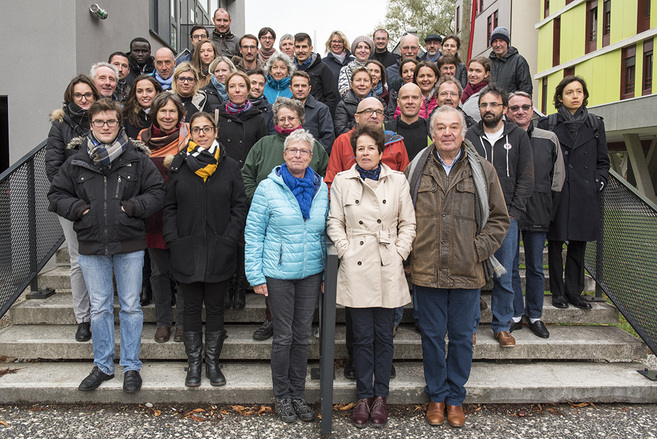
Society and regional strategies Reading time 7 min
Anne Lacroix, good things come to those who apply themselves
Published on 20 November 2017
“INRA has always been a part of my life,” says Anne Lacroix with a laugh. All signs pointed to INRA, from the small town where she was born in Haute-Savoie, where her father was an “innovative farmer” who scoured the newspapers for the latest research, to her high school that was just down the road from INRA’s Thonon-les-Bains lab, where she would end up for good and where she would meet her future husband. After completing her thesis in agricultural economics at INRA’s Grenoble economics laboratory, she was hired as a research engineer in 1983. Amongst the Alpine landscapes and bustling life in Grenoble, she steered her career to align with a particular interest: developing principles for public policies that would shift production and consumer behaviours towards more sustainable agrifood systems. The innovative, imaginative and inventive Anne has always been ahead of her time, setting herself apart through experimental economics, multidisciplinary approaches and taking methodological risks by working with colleagues in other fields. She adopted a process based on dialogue and cooperation with her partners that could only be called participatory research – but before anyone was actually calling it that. For her, this is what the Technological Innovation Award she is receiving this year is all about. .
Economics: bridging the gap between farming and the environment
Until the 1990s, Anne studied the working conditions of farmers, which were difficult with the unfolding economic crisis. She then began looking at the costs and environmental impact of diffuse pollution from agricultural sources. She participated in INRA’s collective scientific expertise on pesticides (1), which remains a reference for public and private stakeholders today. Methodological obstacles abounded at the time, but you can hear in her voice the sheer joy she got from doing what she loved: connecting economists and agronomists, geographers, hydrologists, bioclimatologists, ecologists and other specialists. However, after 14 years, she began to feel that something was missing. “The technical solutions we developed were barely being used, support policies were being ignored. My collaborative efforts, which were almost exclusively with agronomists, were taking me away from what was happening in in the world of economics.” Alban Thomas, the Division Head of INRA SAE2 (2), sees things a little differently. “Anne pulled off an exemplary methodological shift by making the jump from farming and the environment to food.” “I crossed the Rubicon!” she says with a hearty laugh.
A passion for experimental economics
Can consumers drive sustainable development? This concrete and urgent question is Anne’s starting point for developing a scientific research protocol. In her quest to do so, she has turned to experimental economics, a method imported from the United States by Bernard Ruffieux, a long-time colleague and work partner. “Experimental economics is a way to observe the behaviours of economic agents in a controlled and reproducible environment: participants are placed in real conditions and take decisions that have financial or material consequences for them.” While interdisciplinary cooperation has become a new force for INRA, for Anne, it’s just business as usual. She brings together economists, nutritionists, and hedonic and cognitive science. Her project focuses on information available to consumers in food product markets. Anne works with her colleagues to develop original systems, such as an experimental supermarket or a mobile laboratory that lets scientists observe behaviours in underprivileged neighbourhoods. In partnership with the French ministries for health and the environment, her team works to design logos to help consumers make more sustainable food choices. Recently, the Nutriscore logo, which features five different colours, was tested in stores and in the GAEL lab and officially approved. “Our research has a definite impact on public policy decisions and on consumers,” she says with great satisfaction. Along with this success is a partnership with the association CLCV (3), which is working to understand what consumers expect on food labels and the information they use to make decisions. This highly participatory research relies on new experimental tools: tablets and online surveys.
The linchpin
Anne truly enjoys being involved in group projects. “Groups are always a challenge, but I love that!” she says. She has contributed to various working groups in her lab, the division and the Institute to develop, spread the word about and advocate for research support careers. “We need to know what she thinks to before taking decisions at the lab,” says Mariane Damois, a colleague and friend of 40 years and previous 2012 INRA Award winner.
What's next?
Anne knows all the ins and outs of the Grenoble Joint Research Laboratory for Applied Economics by heart. She has watched it change and grow every year with the arrivals of new researchers working on consumption, innovation and, more recently, energy. “It’s exhilarating because it reflects recognition of our scientific appeal, especially with regards to what experimental economics brings to the table. Now, we need to successfully integrate new team members and stay coherent with the lab’s areas of research,” she says as she prepares to start a new phase of her life. Anne plans to take her retirement in 2018, splitting her time between Grenoble and Les Baronnies. But before she does, she must – and will, scout’s honour! – organise her huge stacks of files. What matters most to her is putting the finishing touches on the quality approach she developed to leave things in order for her younger colleagues. For Anne, the scientific validity of applied economics experiments depends on rigorous processes and traceability. Quality standards are pressing while participant cohort groups must be made larger. Anne believes that big data will help bring about new online experimental tools. To effect change in public policies, participatory research that reconciles the logic of researchers and those in the field is needed to produce scientific knowledge that society will accept.

- 63 years old, married with two children (A. Lacroix is now retired)
- 1977: Masters degree in Economics, Université de Grenoble
- 1978: Postgraduate degree in Economics, Université de Grenoble
- 1981: PhD in Development Analysis and Planning, Université de Grenoble
- 1983 to present: Research engineer at UMR GAEL INRA/CNRS/Université de Grenoble/Grenoble INP
- INRA’s Auvergne-Rhône-Alpes Research Centre
- Research division: SAE2
- 2010-2017: Member of the UMR GAEL Advisory Board
- 2010-2017: Leader of the “Consumer behaviour” team at her lab
- 2006-2016: Elected member of the SAE2 Division Management Board
- 2005-2017: Appointed member of the INRA Engineers Evaluation Committee
- 2015-2017: Staff representative on the National Joint Administrative Committee of Research Engineers
Awards and distinctions
- 2017 INRA Technological Innovation Award
Hobbies
- A nature enthusiast who loves the countryside, especially around the Drôme area in Provence.
- Adores the culture of Mediterranean countries.
- Home DIYer: she loves repurposing items to not be part of a throwaway culture.
- Other interests: yoga, Pilates, reading, cinema, travel.
